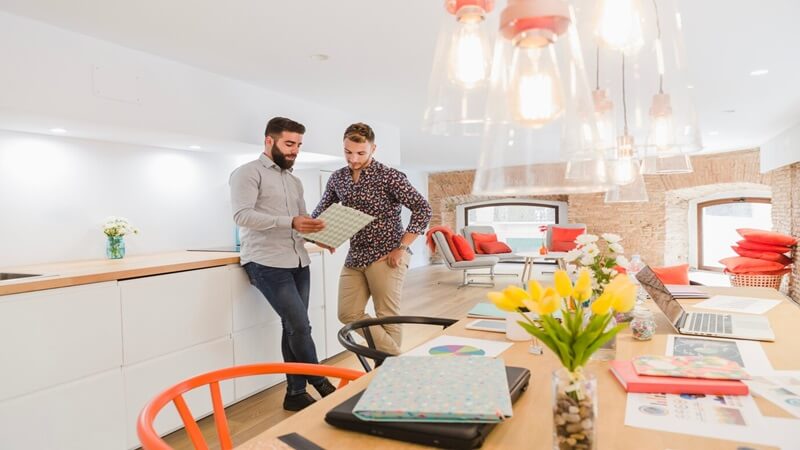Interior design is more than just arranging furniture or picking the right color. It’s about creating harmony, movement, and character within a space. One of the most underrated yet impactful principles in this field is opposition in interior design. This concept goes beyond simple contrast; it’s a strategic balance that creates tension, interest, and focus.
By using opposing elements—such as light and dark, rough and smooth, or modern and traditional—designers can transform a plain space into a visual masterpiece. Let’s explore what this means and how you can apply it effectively.
What Is Opposition in Interior Design?
Opposition, in the context of design, refers to the deliberate use of contrasting elements to create visual interest or highlight specific features. These opposites can exist in:
-
Color (light vs. dark)
-
Texture (smooth vs. coarse)
-
Shape (geometric vs. organic)
-
Style (modern vs. vintage)
-
Scale (large vs. small)
When used wisely, these contrasts do not clash—they complement. The key is balance.
For example, a smooth leather couch placed next to a rustic wooden table doesn’t feel odd. Instead, it adds depth and invites attention. Opposition in interior design brings life to a space by ensuring that nothing feels monotonous.
Types of Opposition Used by Designers
1. Color Opposition
This is one of the most instantly noticeable forms. Think of black and white, navy and gold, or red and green. Using opposing colors from the color wheel (complementary colors) can add drama and focus. A designer might pair a deep navy wall with bright orange cushions for a bold statement.
But the use of color opposition doesn’t have to be loud. Soft opposites like beige and charcoal or pale blue and terracotta can offer a subtler impact.
2. Textural Opposition
Textures influence how we perceive a room. Mixing different textures—like pairing a glossy marble floor with a shaggy wool rug—adds tactile interest. Rough stone walls combined with sleek metal furniture create an intriguing sensory contrast.
Textural opposition is particularly effective in minimalist spaces. Where color is kept neutral, texture becomes the hero.
3. Shape and Form
Opposition in shape helps maintain visual balance. A round mirror above a rectangular console table creates a pleasing juxtaposition. Curved furniture pieces in a room full of straight lines introduce softness and flow.
This principle also applies to accessories. Sculptures, vases, or lighting fixtures with opposing shapes can stand out and function as focal points.
4. Material Contrast
Designers often use materials in contrast to create depth. For example, a room might feature a glass coffee table next to a heavy iron lamp or an industrial metal bookshelf against a velvet chair.
Each material brings its own mood. When you contrast them, you also contrast those moods—creating layered complexity.
How to Apply Opposition in Your Own Space
You don’t need to be a professional to use this concept. Here’s how you can apply opposition in interior design at home:
Start with One Element
Begin with a base element like your flooring or sofa, then introduce an opposite. If your couch is soft and plush, balance it with a side table made of raw timber or concrete.
Use the Rule of Thirds
Too much contrast can overwhelm. Aim to use opposition in about a third of the room, allowing the rest to act as visual breathing space.
Keep a Cohesive Palette
Even when contrasting, ensure the colors or textures fall within a cohesive scheme. For instance, you can contrast beige and navy, but make sure other elements tie them together—like gold hardware or wooden accents.
Opposition in Interior Design and Focal Points
Opposition naturally draws attention, which is why it’s a great tool for establishing focal points. Want to highlight a fireplace? Place a mirror with a contrasting frame above it. Want to draw the eye to a gallery wall? Use frames in various shapes or contrasting finishes.
Designers often rely on opposition to guide the viewer’s gaze intentionally, leading them through a room the way a storyteller leads a reader through a narrative.
Common Mistakes to Avoid
Overusing Contrast
While opposition is powerful, too much of it leads to chaos. If everything in a room is screaming for attention, nothing stands out. Use opposition sparingly and purposefully.
Ignoring Unity
Opposition should be grounded in unity. This means that even contrasting elements should feel like they belong together. For example, a vintage chair and a modern table may contrast in style, but a similar fabric or finish can create cohesion.
Lack of Purpose
Each opposing element should serve a purpose—either to highlight, balance, or contrast. Avoid using opposition for the sake of it.
Case Study: How Designers Use Opposition in Real Homes
Consider a Scandinavian-style living room. It might feature a palette of whites and soft greys, but a designer could introduce a matte black pendant lamp and a dark oak coffee table to add depth. These opposing elements don’t fight with the minimal aesthetic—they enhance it.
In another case, a loft with exposed brick walls (textural and raw) might be softened with lush velvet sofas and delicate lighting fixtures. This interplay of rough and refined captures the essence of opposition in interior design beautifully.
Why Opposition Makes a Room Feel “Complete”
A room that lacks contrast often feels flat. When every element is soft, light, or neutral, there’s no tension. That tension is what brings energy. The viewer’s eyes need something to explore, something that surprises and delights.
Opposition allows for emotional storytelling. A home can feel cozy, bold, mysterious, and sophisticated—all at once—when opposing elements coexist in harmony.
This is especially important in open-concept layouts. Opposition helps in subtly defining zones and moods without the need for physical barriers.
Tips from Interior Design Experts
-
Think in Layers: Start with foundational pieces, then add contrasting textures, shapes, and finishes on top.
-
Balance With Symmetry: If one side of a room has bold elements, balance them with equally strong—but opposing—features on the other side.
-
Mix Styles Confidently: Pair traditional elements with modern ones. A tufted Victorian chair beside a minimalist lamp? It works when done right.
-
Use Lighting as an Opposing Element: Bright and dim lighting can contrast beautifully. Layer natural and artificial light for maximum effect.
Conclusion: The Beauty of Thoughtful Contrast
When done right, opposition in interior design is not a clash—it’s a conversation. It makes your home feel intentional, dynamic, and visually satisfying. Rather than overwhelm, it draws the eye, balances the space, and elevates even the simplest interiors into something expressive.
By understanding how and when to use opposition, you can master the delicate dance between harmony and contrast. Whether you’re designing a room from scratch or refreshing a space, remember: sometimes, opposites don’t just attract—they complete each other.
For more info visit Stylish Home

